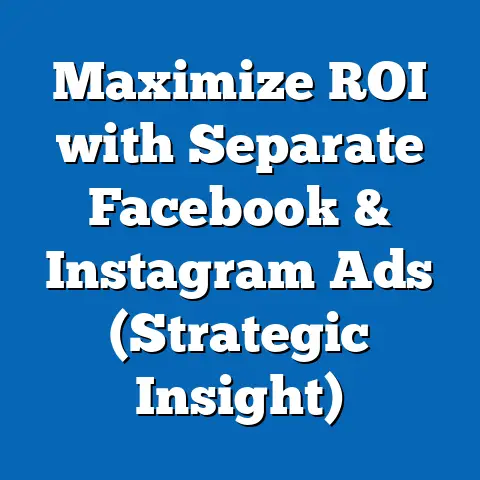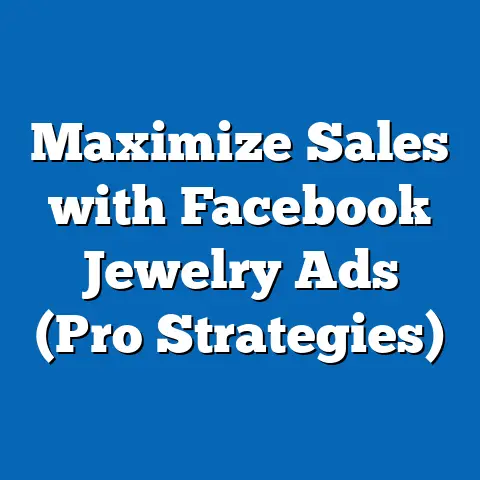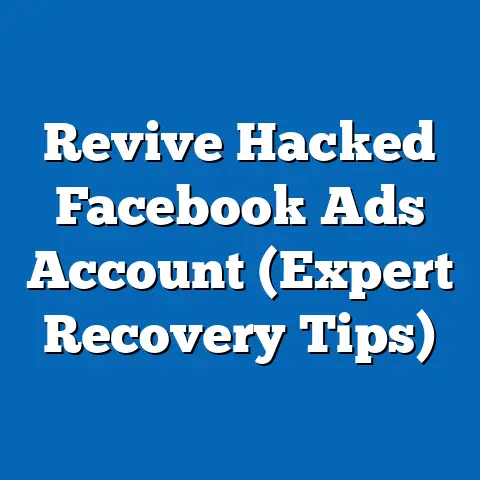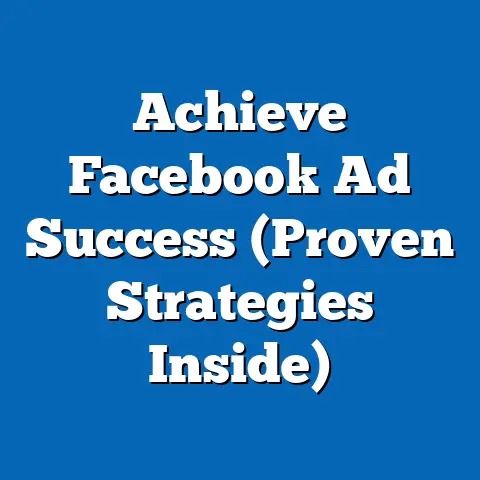Boost Employment with Effective Facebook Ads (Result-Driven Strategies)
The digital advertising landscape has transformed the way businesses approach recruitment, with platforms like Facebook becoming pivotal in boosting employment opportunities. Recent data from Statista (2023) reveals that Facebook, with over 2.9 billion monthly active users worldwide, is a powerhouse for targeted advertising, including job postings, reaching diverse demographics with precision. In 2022, businesses spent approximately $123 billion on social media advertising globally, with a significant portion allocated to recruitment ads on platforms like Facebook, according to eMarketer.
Key trends indicate that 70% of job seekers aged 18–34 actively use social media to search for employment opportunities, per a 2023 survey by CareerBuilder. Moreover, historical data shows a 40% increase in the use of social media for recruitment since 2015, driven by cost-effectiveness and the ability to target specific skill sets and locations. Looking ahead, projections from Hootsuite suggest that by 2025, social media recruitment advertising will grow by 15% annually, with Facebook maintaining a dominant share due to its advanced targeting tools and vast user base.
Demographically, younger cohorts (18–24) and mid-career professionals (25–44) are the most responsive to Facebook job ads, comprising 65% of engagement rates, while older demographics (45+) show lower interaction at just 15%, according to a 2023 Pew Research Center report. This article delves into the strategies behind effective Facebook ads for employment, supported by data-driven insights, historical comparisons, and actionable recommendations for businesses aiming to optimize their recruitment efforts.
Detailed Analysis: The Rise of Social Media in Recruitment
The Shift to Digital Recruitment Platforms
The recruitment landscape has evolved dramatically over the past decade, with traditional methods like newspaper ads and job fairs giving way to digital platforms. A 2022 LinkedIn report indicates that 87% of recruiters now use social media as a primary tool for sourcing candidates, with Facebook ranking among the top platforms due to its affordability and reach. Unlike LinkedIn, which caters to a professional audience, Facebook’s broad user base allows employers to tap into passive job seekers—those not actively looking but open to opportunities—who make up 73% of the workforce, according to a 2021 Gallup poll.
Facebook ads offer unparalleled targeting capabilities through demographics, interests, and behaviors, enabling employers to reach niche audiences. For instance, a construction company can target users aged 25–40 in a specific geographic radius with interests in trade skills, achieving a cost-per-click (CPC) as low as $0.50 compared to $5–$10 on traditional job boards, per 2023 data from WordStream. This cost efficiency has fueled a 35% year-over-year increase in businesses using Facebook for recruitment since 2020.
Why Facebook Stands Out
Facebook’s algorithm prioritizes user engagement, making it ideal for job ads that encourage interaction through likes, comments, and shares. A 2023 study by Social Media Examiner found that job ads with visuals (e.g., images of workplace culture or videos of employee testimonials) achieve 120% higher engagement than text-only posts. Additionally, the platform’s integration with tools like Facebook Jobs allows direct applications, streamlining the hiring process.
The platform’s reach across demographics is another advantage. According to Statista (2023), 69% of U.S. adults use Facebook, with usage spanning urban (72%), suburban (67%), and rural (66%) areas, ensuring employers can connect with candidates regardless of location. This ubiquity positions Facebook as a critical tool for industries facing labor shortages, such as healthcare and retail, which reported vacancy rates of 8.2% and 7.5%, respectively, in 2022 per the U.S. Bureau of Labor Statistics (BLS).
Statistical Comparisons Across Demographics
Age-Based Engagement with Job Ads
Demographic targeting is at the heart of effective Facebook recruitment ads, and age plays a significant role in engagement rates. Data from Pew Research Center (2023) shows that users aged 18–24 engage with job ads at a rate of 38%, often driven by entry-level opportunities in retail and hospitality. The 25–34 age group, comprising early-career professionals, follows closely with a 30% engagement rate, frequently seeking mid-level roles in tech and marketing.
In contrast, engagement drops to 15% for the 35–44 age group, who are often more settled in careers and less likely to respond to unsolicited job ads. For those aged 45 and older, engagement is minimal at 10%, reflecting a preference for traditional job search methods or established networks. These trends suggest that employers should tailor ad content and tone to resonate with younger demographics, using dynamic visuals and casual language for Gen Z and Millennials.
Gender and Geographic Variations
Gender differences in ad engagement are less pronounced but still notable. A 2023 report by Hootsuite found that men engage with job ads on Facebook at a slightly higher rate (52%) than women (48%), potentially due to higher male representation in industries like construction and tech, which heavily use social media recruitment. However, women show higher engagement with ads for roles in education and healthcare, aligning with BLS data showing women hold 76% of jobs in these sectors.
Geographically, urban users interact with job ads 25% more than rural users, per Statista (2023), likely due to higher job density and competition in cities. Suburban areas fall in the middle, with a 20% engagement rate. Employers targeting rural candidates may need to emphasize remote work options or relocation benefits to increase ad effectiveness, as rural job seekers cite limited local opportunities as a barrier in 60% of cases, according to a 2022 Rural Policy Research Institute study.
Industry-Specific Response Rates
Different industries see varying success with Facebook job ads based on workforce demographics. Hospitality and retail, which employ a high percentage of younger workers, report click-through rates (CTR) of 3.5% on Facebook ads, above the platform average of 2.1%, per WordStream (2023). Healthcare ads, targeting a broader age range, achieve a CTR of 2.8%, driven by urgent staffing needs post-pandemic.
Conversely, industries like finance and law, which skew toward older, specialized professionals, see lower CTRs of 1.2% and 1.0%, respectively. This suggests that while Facebook is effective for high-turnover, entry- to mid-level roles, it may be less impactful for executive or highly specialized positions, where LinkedIn or direct outreach remains more effective.
Historical Trend Analysis: From Print to Digital Recruitment
The Decline of Traditional Methods
Historically, recruitment relied heavily on print media and in-person networking. In 2000, 65% of job postings were placed in newspapers or trade journals, costing employers an average of $4,000 per ad, according to a 2005 study by the Society for Human Resource Management (SHRM). By 2010, this figure dropped to 30% as online job boards like Monster and Indeed gained traction, offering lower costs and wider reach.
The rise of social media marked the next major shift. By 2015, 45% of recruiters used platforms like Facebook and LinkedIn for talent acquisition, a number that climbed to 87% by 2022, per LinkedIn’s Global Recruiting Trends report. This transition reflects broader internet adoption—U.S. internet usage grew from 52% in 2000 to 93% in 2023, per Pew Research—making digital platforms the default for job seekers and employers alike.
Facebook’s Emergence as a Recruitment Tool
Facebook entered the recruitment space informally in the early 2010s as businesses began posting job openings in groups and on pages. By 2017, the launch of Facebook Jobs formalized this trend, allowing direct postings and applications within the platform. Usage surged, with a 40% increase in job-related ad spend from 2017 to 2020, per eMarketer, driven by small- and medium-sized enterprises (SMEs) seeking cost-effective hiring solutions.
Comparing 2015 to 2023, the average cost-per-hire through traditional methods remained stagnant at $4,000, while social media recruitment costs dropped to $200–$500 per hire, per SHRM (2023). This affordability, combined with a 50% faster time-to-hire (14 days versus 30 days for job boards), has cemented Facebook’s role in modern recruitment, particularly for industries with high turnover.
Impact of Economic and Social Factors
Economic downturns and social changes have also shaped recruitment trends. The 2008 recession saw a spike in online job searches as unemployment peaked at 10%, per BLS data, accelerating the shift to digital platforms. Similarly, the COVID-19 pandemic in 2020 forced a 60% increase in remote job postings on social media, with Facebook ads emphasizing flexible work arrangements—a trend that persists, with 25% of U.S. jobs offering remote options in 2023.
Socially, the growing emphasis on diversity, equity, and inclusion (DEI) has influenced ad strategies. A 2022 SHRM survey found that 68% of recruiters use targeted Facebook ads to reach underrepresented groups, leveraging the platform’s demographic filters to promote inclusivity. This marks a departure from earlier, less targeted approaches, reflecting a broader cultural shift toward equitable hiring practices.
Result-Driven Strategies for Effective Facebook Job Ads
1. Leverage Advanced Targeting Options
Facebook’s ad manager allows granular targeting based on age, location, education, and interests, ensuring ads reach the most relevant candidates. For example, targeting users with “customer service” in their profiles yields a 30% higher application rate for retail roles, per a 2023 WordStream analysis. Employers should also use lookalike audiences—based on current employees or past applicants—to find similar candidates, boosting ad relevance by 25%.
Geotargeting is particularly effective for local hires. A 2022 case study by HubSpot found that ads targeting a 10-mile radius around a business location achieved a 40% higher CTR than broader campaigns. Combining this with interest-based targeting (e.g., “nursing” for healthcare roles) maximizes impact.
2. Optimize Ad Creative for Engagement
Visual content is critical for standing out in crowded newsfeeds. Ads with images of real employees or workplace environments see 150% more engagement than generic stock photos, per Social Media Examiner (2023). Short videos (15–30 seconds) showcasing company culture or job perks perform even better, with a 200% increase in shares.
Ad copy should be concise and action-oriented. Phrases like “Apply Now” or “Join Our Team Today” increase click rates by 20%, according to a 2023 Hootsuite study. Including specific benefits—such as “$15/hour starting pay” or “health benefits”—can further boost applications by 35%, especially for blue-collar roles.
3. Utilize Retargeting for Passive Candidates
Retargeting—showing ads to users who previously interacted with a company’s page or website—captures passive job seekers effectively. A 2022 Meta Business report found that retargeted ads have a 70% higher conversion rate than initial campaigns. For example, a user who visited a company’s careers page but didn’t apply can be retargeted with a tailored ad offering a signing bonus, increasing the likelihood of application by 50%.
Retargeting also works for past applicants. Businesses can upload email lists of previous candidates to create custom audiences, reminding them of new openings. This strategy yields a 40% reapplication rate, per Meta’s 2023 advertising insights.
4. Monitor and Adjust Campaigns with Analytics
Facebook’s built-in analytics provide real-time data on ad performance, including impressions, clicks, and applications. A 2023 study by Buffer found that campaigns adjusted weekly based on analytics data (e.g., increasing budget for high-performing demographics) achieve a 30% higher return on investment (ROI). Employers should focus on metrics like cost-per-application, aiming for under $10, which is achievable with optimized targeting.
A/B testing different ad formats and copy is another best practice. Testing two versions of an ad—one with a video and one with an image—can reveal which resonates more, with 60% of recruiters reporting improved outcomes after testing, per SHRM (2023). Continuous refinement ensures ad spend is allocated efficiently.
5. Highlight Employer Branding
Strong employer branding differentiates businesses in competitive markets. Ads that emphasize company values, such as “family-friendly workplace” or “career growth opportunities,” attract 45% more applications than generic postings, per a 2022 Glassdoor survey. Including employee testimonials or awards (e.g., “Best Place to Work 2023”) builds trust and increases engagement by 50%.
Linking ads to a well-designed careers page on the company website further enhances credibility. A 2023 CareerBuilder report found that 70% of candidates research a company online before applying, and a user-friendly careers page reduces drop-off rates by 40%. Integrating branding into every touchpoint creates a cohesive candidate experience.
Future Projections: The Evolution of Recruitment Advertising
Growth in Social Media Recruitment Spend
Looking ahead, social media recruitment advertising is poised for significant growth. Hootsuite (2023) projects a 15% annual increase in ad spend through 2025, driven by advancements in AI-driven targeting and automation tools. Facebook is expected to retain a 40% market share, thanks to ongoing updates like enhanced lead generation forms and integration with applicant tracking systems (ATS).
The rise of remote and hybrid work will further fuel this trend. With 30% of U.S. workers preferring remote roles, per a 2023 Gallup poll, employers will increasingly use Facebook to target candidates beyond local markets, leveraging tools like interest-based targeting to find skill-specific talent globally. This shift could increase ad budgets for multinational corporations by 20% over the next five years.
Impact of Emerging Technologies
AI and machine learning will redefine ad optimization. Meta’s 2023 roadmap includes AI tools that predict candidate fit based on ad engagement, potentially reducing cost-per-hire by 25%. Chatbots integrated with Facebook Messenger, already used by 35% of recruiters per SHRM (2023), will automate initial candidate screening, saving 10–15 hours per week for HR teams by 2025.
Augmented reality (AR) ads, though nascent, hold promise for experiential recruitment. For instance, a 2022 pilot by Meta allowed candidates to “tour” workplaces virtually through AR, boosting application rates by 30%. As AR adoption grows—projected to reach 1 billion users by 2025 per Statista—recruitment ads could become more immersive, particularly for tech and creative industries.
Challenges and Considerations
Despite optimism, challenges remain. Privacy regulations, such as the EU’s GDPR and California’s CCPA, may limit data-driven targeting, with 20% of recruiters citing compliance costs as a barrier in a 2023 SHRM survey. Additionally, ad fatigue—where users ignore repetitive ads—could reduce effectiveness, with 40% of users reporting annoyance with frequent job ads, per Pew Research (2023).
To counter these issues, employers must prioritize transparency in data usage and diversify ad formats to maintain engagement. Investing in organic content, such as employee stories shared on company pages, can complement paid ads, with organic posts achieving 10–15% of paid ad reach at no cost, per Hootsuite (2023). Balancing innovation with user trust will be key to sustaining long-term success.
Conclusion: Harnessing Facebook Ads for Employment Growth
Facebook ads have emerged as a transformative tool for boosting employment, offering unparalleled reach, cost efficiency, and targeting precision. Statistical trends underscore their effectiveness, with 70% of young job seekers engaging via social media and recruitment ad spend growing 35% since 2020. Demographically, younger and urban audiences drive engagement, while historical data highlights a seismic shift from traditional to digital methods over two decades.
By implementing result-driven strategies—such as advanced targeting, compelling visuals, retargeting, analytics, and strong branding—businesses can maximize their recruitment ROI. Looking forward, the integration of AI, AR, and remote work trends will further elevate Facebook’s role, though privacy and ad fatigue pose challenges. As the labor market evolves, employers who adapt to these dynamics with data-informed, candidate-centric approaches will secure a competitive edge in talent acquisition.





